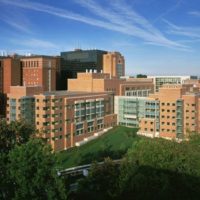
The Clinical Center of the National Institutes of Health
NIH
For serving since its inception as a model research hospital — providing innovative therapy and high-quality patient care, treating rare and severe diseases, and producing outstanding physician-scientists whose collective work has set a standard of excellence in biomedical research.
The 2011 Lasker~Bloomberg Public Service Award honors an institution that has served since its inception as a model research hospital. Since 1953, the Clinical Center of the National Institutes of Health (NIH) has provided innovative therapy and high-quality patient care, treated rare and severe diseases, and produced outstanding physician-scientists whose collective work has set a standard of excellence in biomedical research. It has spearheaded major advances in a wide array of medical arenas, established an example for academic institutions across the world, and trained thousands of investigators, many of whom now lead those establishments.
On July 6, 1953, the NIH Clinical Center admitted its first patient and embarked on its mission to generate new ways to diagnose, treat, and prevent disease by connecting bedside observations with laboratory inquiries. Patterned after a similar design at the Rockefeller University Hospital (New York City), the NIH’s Center scaled up the endeavor to create a larger institution with vastly more patient-recruiting power. By grappling with perplexing illnesses in a setting where laboratories and hospital beds share a building, the Center united basic-science researchers, clinicians, and patients in their shared goal of understanding and combating disease. Today, 18 of the 27 NIH Institutes and Centers, each of which focuses on a particular biomedical realm, rely on the Center. There, scientists can benefit human beings by applying knowledge they have gleaned from experiments on cells and animals. Specialists from all over the NIH join forces with each other, the highly skilled hospital staff, and the patients.
Award presentation by Harvey Fineberg
 As chair of the Lasker Foundation’s Public Service Award Committee, it is my privilege to introduce the recipient of the 2011 Lasker~Bloomberg Public Service Award.
As chair of the Lasker Foundation’s Public Service Award Committee, it is my privilege to introduce the recipient of the 2011 Lasker~Bloomberg Public Service Award.
The 2011 Public Service Award goes not to an individual, but to an institution, and not for a single discovery, but for sustained and singular contributions to health. Establishment of the Clinical Center at the NIH in 1953 was a far-sighted investment by the US government: it created a model for the fully engaged, research-intensive, academic medical center, and the NIH Clinical Center went on to train some of the country’s most esteemed medical scientists.
Acceptance remarks by John Gallin on behalf of the Clinical Center of the NIH
President Freire, members of the Lasker Foundation Board, Jury members, and distinguished guests,
What a wonderful gift Congress gave to the American public, and to the world, when it created the Clinical Center at NIH in 1947, a hospital literally wrapped in research laboratories to enable clinical research studies. You have heard already about the role the Clinical Center plays in serving as a model institution for training today’s investigators and discovering tomorrow’s cures. The Clinical Center, situated less than 10 miles from the heart of our nation’s capital, is very much a living monument to our country’s sustained commitment to clinical research. It is a place where the bench to bedside cycle, which translates basic science discoveries into new treatments and cures to improve public health, is a part of everyday life.
Interview with The Clinical Center of the National Institutes of Health
Video Credit: Susan Hadary
